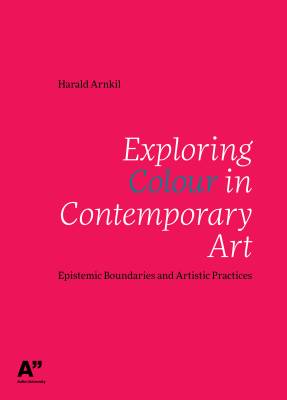Exploring Colour in Contemporary Art — Epistemic Boundaries and Artistic Practices
Arnkil, HaraldTuotetiedot
| Nimeke: | Exploring Colour in Contemporary Art — Epistemic Boundaries and Artistic Practices | ||
| Tekijät: | Arnkil, Harald (Kirjoittaja) | ||
| Tuotetunnus: | 9789526425269 | ||
| Tuotemuoto: | Pehmeäkantinen kirja | ||
| Saatavuus: | Toimitusaika 1-3 arkipäivää | ||
| Ilmestymispäivä: | 30.5.2025 | ||
| Hinta: | 56,00 € (49,12 € alv 0 %) | ||
|
|||
| Kustantaja: | Aalto-yliopiston taiteiden ja suunnittelun korkeakoulu |
| Sarja: | Aalto-yliopiston julkaisusarja Doctoral Theses 83 |
| Painos: | 2025 |
| Julkaisuvuosi: | 2025 |
| Kieli: | englanti |
| Sivumäärä: | 511 |
| Tuoteryhmät: | Kaikki tuotteet Tietokirjallisuus Taide |
| Kirjastoluokka: | 70.01 Taiteen estetiikka |
| Avainsanat: | väitöskirja, väri, nykytaide, taiteenfilosofia |
This thesis is the result of exploring contemporary artists' approaches to colour and comparing those approaches with notions of colour in colour philosophy, philosophy of art and artistic colour theories. How do contemporary artists use colour in their works and artistic actions? What governs or guides their choice of colours? What is the relation of colour theories to contemporary art praxis?
The research is in six parts. Part 1, Nine conversations, presents interviews that I have made with nine contemporary artists, Kristi Kongi, Jussi Goman, Vesa-Pekka Rannikko, Inka Kivalo, Lois Swirnoff, Nathalie Miebach, Douglas Breault, Ann Veronica Janssens and David Batchelor, about their ways of using colour in their art. Part 2, Epistemology of colour, is an overview of current ontology and epistemology of colour. Part 3, Philosophies about colour in art, is a discussion of texts about colour in art by the French philosophers Mikel Dufrenne, Maurice Merleau-Ponty, Gilles Deleuze, Jean-François Lyotard and Michel Henry. Part 4, Guidelines, rules and theories for artists, is a review of recent texts and theories about colour which have been written specifically for artists by artists and art pedagogues. Part 5, Contemporary colours, takes a look at approaches, methods and applications of colour by contemporary artists, beginning with examples from artists of the groups Gutai and Nouveau réalisme and ending with present-day examples. The thesis ends in Part 6 with final conclusions and a discussion of unanswered questions and some further thoughts.
The research is in six parts. Part 1, Nine conversations, presents interviews that I have made with nine contemporary artists, Kristi Kongi, Jussi Goman, Vesa-Pekka Rannikko, Inka Kivalo, Lois Swirnoff, Nathalie Miebach, Douglas Breault, Ann Veronica Janssens and David Batchelor, about their ways of using colour in their art. Part 2, Epistemology of colour, is an overview of current ontology and epistemology of colour. Part 3, Philosophies about colour in art, is a discussion of texts about colour in art by the French philosophers Mikel Dufrenne, Maurice Merleau-Ponty, Gilles Deleuze, Jean-François Lyotard and Michel Henry. Part 4, Guidelines, rules and theories for artists, is a review of recent texts and theories about colour which have been written specifically for artists by artists and art pedagogues. Part 5, Contemporary colours, takes a look at approaches, methods and applications of colour by contemporary artists, beginning with examples from artists of the groups Gutai and Nouveau réalisme and ending with present-day examples. The thesis ends in Part 6 with final conclusions and a discussion of unanswered questions and some further thoughts.


